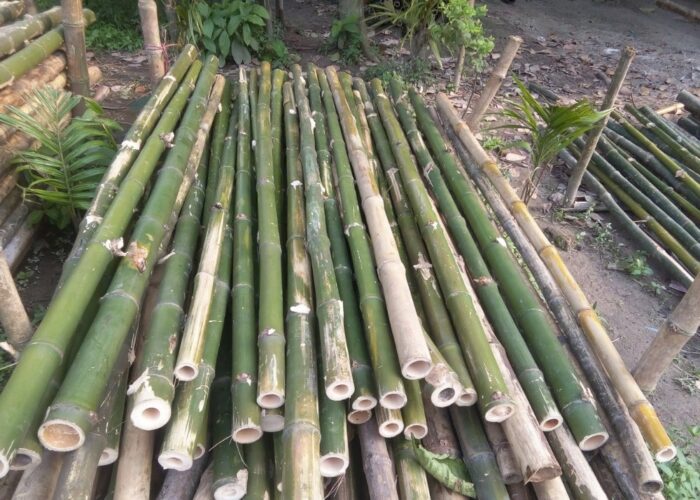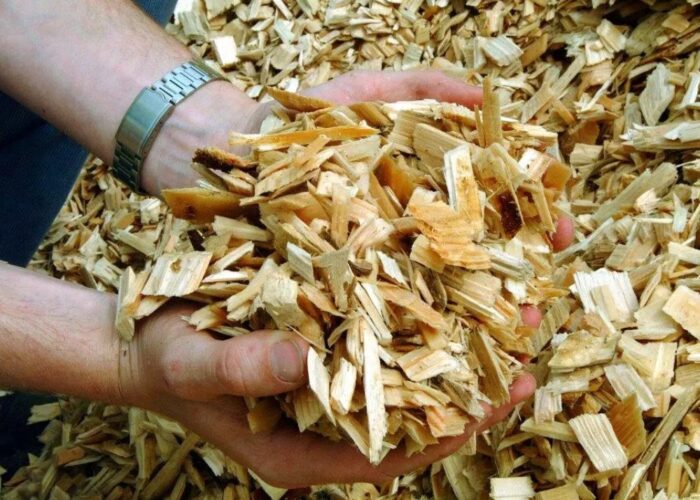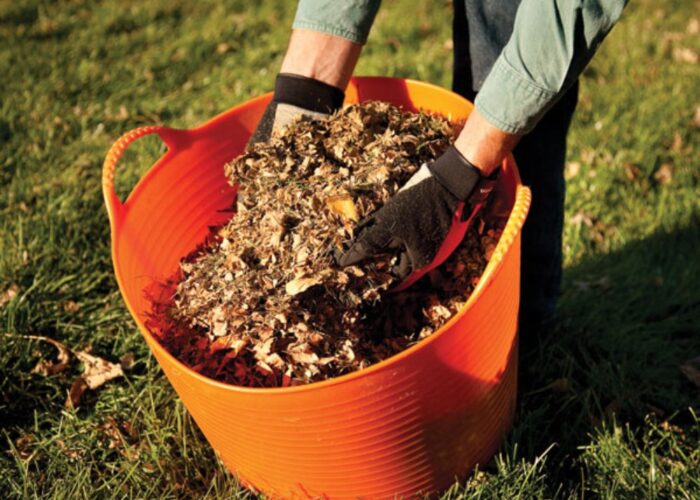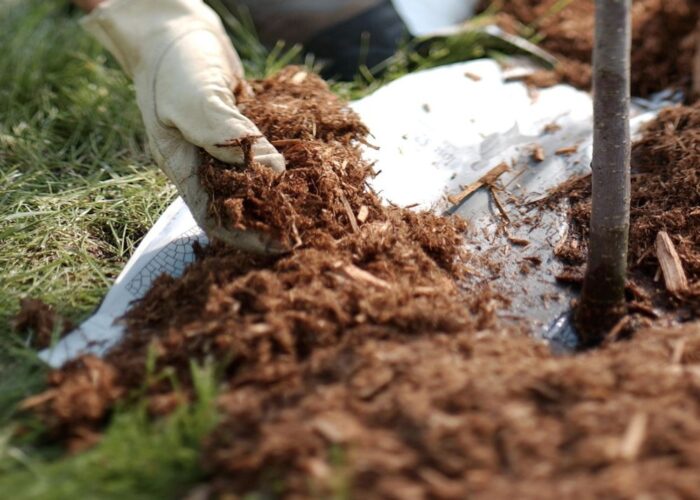In today’s era, using natural and sustainable materials in agriculture is becoming increasingly popular. One environmentally friendly and effective method is using bamboo mulch, a type of surface cover made from bamboo. This article will guide you on how to make bamboo mulch, from selecting materials to the processing steps, so you can maximize its benefits for improving soil, retaining moisture, and naturally preventing weeds. This is not only a way to enhance the health of your garden but also contributes to protecting our surrounding environment.
1. Steps to make bamboo mulch?
Creating bamboo mulch is a straightforward process that involves several steps. Here’s a guide to help you through the materials needed and the step-by-step procedure:
Materials Needed:
- Bamboo
- Cutting Tools
- Chipper/Shredder (Optional)
- Gloves
- Protective Gear
- Container or Bag
Steps by step:
Step 1: Harvest or Obtain Bamboo
Select mature bamboo stalks that are around 1-2 years old. Older bamboo tends to be harder and more difficult to shred.
Step 2: Prepare the Bamboo
First, cut the bamboo stalks into manageable sections using pruning shears or a saw. If you have a lot of bamboo, cutting them into smaller pieces will make shredding easier. Next, remove any leaves and smaller branches to ensure you have clean bamboo stalks ready for shredding.

Step 3: Shred the Bamboo
For manual shredding, use a machete or handsaw to cut the bamboo into small pieces if you don’t have a chipper or shredder. While this method is labor-intensive, it works well for smaller quantities. For larger amounts, use a chipper or shredder. Follow the manufacturer’s instructions to feed the bamboo sections into the machine, which will break them down into mulch-sized pieces.

Step 4: Process and Dry
After shredding, spread the bamboo mulch out in a thin layer and let it air dry. This step is crucial to prevent mold and ensure the mulch is ready for use. Depending on the climate, drying may take a few days to a week.
Step 4: Store the Mulch
Once the bamboo mulch is dry, collect it into containers or bags for storage. Ensure that the storage area is dry and well-ventilated to keep the mulch in good condition.

Step 5: Apply the Mulch
When ready to use, spread the bamboo mulch evenly over the soil in your garden beds. Apply a layer about 2-4 inches thick to help retain moisture, suppress weeds, and improve soil health.

By following these steps, you can create your own bamboo mulch, which is a sustainable and effective way to enhance your garden.
2. Benefits of using bamboo mulch
- Improves Soil Health
Bamboo mulch significantly improves soil health by adding valuable organic matter as it decomposes, which enriches the soil with essential nutrients. This process enhances soil structure and fertility, fostering healthier plant growth. Additionally, the organic material in bamboo mulch promotes beneficial microbial activity in the soil. These microorganisms assist in breaking down organic matter and increasing nutrient availability for plants.
- Moisture Retention
Bamboo mulch excels at moisture retention by acting as a barrier that reduces water evaporation, which is especially beneficial during hot, dry periods. This helps keep plants hydrated and lessens the need for frequent watering. Additionally, by covering the soil, bamboo mulch prevents the formation of a hard crust on the soil surface, which can impede water infiltration and hinder root growth.
- Weed Suppression
A thick layer of bamboo mulch blocks sunlight from reaching weed seeds, which reduces their germination and growth, helping to keep your garden weed-free and minimizing the need for chemical herbicides. Additionally, by providing a physical barrier, bamboo mulch prevents weed seeds from blowing into your garden from surrounding areas.
- Temperature Regulation
In cooler weather, it retains heat, helping to keep the soil warmer for plant roots, while in hot weather, it provides shade and keeps the soil cooler. Additionally, the mulch layer helps prevent soil erosion caused by wind and rain, protecting the topsoil and maintaining soil structure.
- Environmental Benefits
As a rapidly renewable resource, bamboo serves as an eco-friendly alternative to other types of mulch, helping to reduce reliance on non-renewable materials and supporting sustainable gardening practices. Additionally, by recycling bamboo stalks that might otherwise be discarded, bamboo mulch contributes to reducing garden and yard waste.
- Aesthetic Appeal
Bamboo mulch enhances the aesthetic appeal of gardens with its natural, earthy appearance that seamlessly blends with various garden styles. Its color and texture can significantly improve the visual appeal of garden beds and landscapes. Additionally, the consistency of bamboo mulch provides a neat, uniform coverage, further enhancing the overall look of your garden.
- Cost-Effective
Bamboo mulch is a cost-effective option, especially if you have access to bamboo for making your own. Creating your own mulch is often less expensive than purchasing commercial alternatives. Additionally, bamboo mulch’s durability reduces the need for frequent replacements, further saving costs over time.
By incorporating bamboo mulch into your gardening routine, you can enjoy these benefits while contributing to a more sustainable and eco-friendly garden.
3. FAQs
Can you use bamboo leaves as mulch?
Yes, you can use bamboo leaves as mulch. Bamboo leaves decompose relatively quickly, adding organic matter and nutrients to the soil. They also help retain moisture, suppress weeds, and regulate soil temperature. Just make sure to shred or chop them up a bit before using them as mulch to help them break down more evenly.
Is bamboo mulch good for all plants?
Bamboo mulch can be highly beneficial for many plants due to its ability to add organic matter and nutrients to the soil, help retain moisture, and effectively suppress weeds. However, it decomposes relatively quickly, so it may need to be replenished more frequently compared to other mulches. Additionally, because bamboo mulch can be high in silica, it might affect soil pH over time, which could impact plants that are sensitive to pH changes. Therefore, while bamboo mulch is generally a good option, it’s important to consider the specific needs of your plants and monitor soil conditions accordingly.
What happens if bamboo mulch sprouts?
If bamboo mulch sprouts, it means the bamboo seeds or rhizomes in the mulch have germinated. This can lead to unwanted bamboo growth in your garden. To manage this, regularly remove the sprouts and consider using a mulch that is free of seeds or rhizomes to prevent future sprouting.
If you have any further questions, don’t hesitate to send thanhcongcraft an email us at info@thanhcongcraft.com or message us at WhatsApp: +84967485411. Hope to serve you soon! Best regard!


